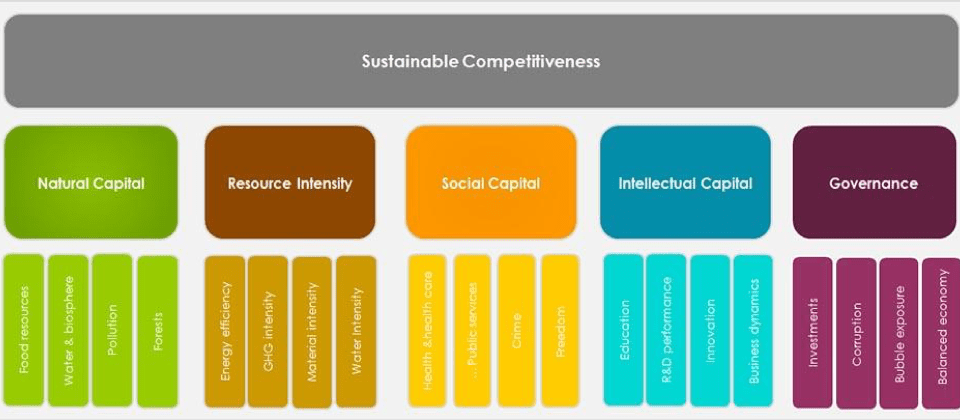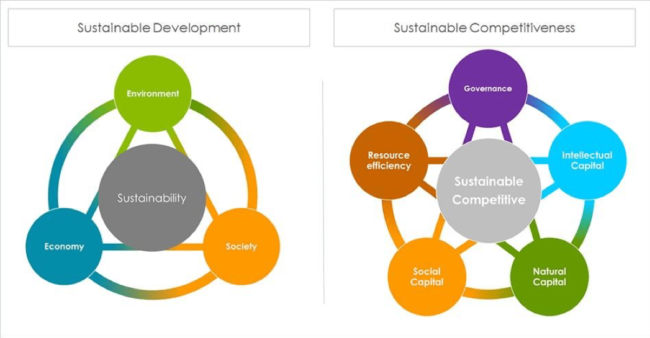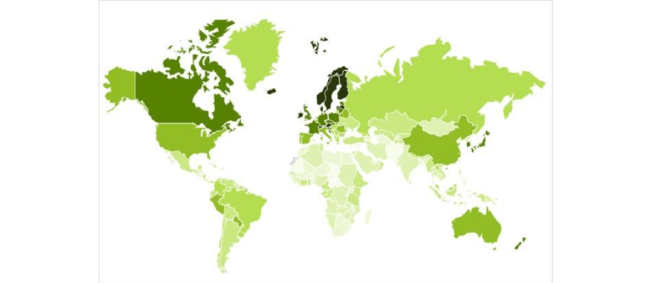GDP is an insufficient measurement of success and competitiveness.
The competitiveness of a country is – traditionally – closely associated with GDP (or GNI), either measured in total or per capita. Alternatively, there are indexes – in particular the WEFs “Competitiveness Index” that try to measure conventional aspects of competitiveness (and show a very strong correlation to GDP). However, in times of multiple threats to the environment and biodiversity, and rising inequality on all levels (between different population segments, groups, regions, countries, and even continents), GDP and other conventional measurements neither reflect the reality of the current state nor the outlook of “competitiveness” of nations. GDP reflects the current economic power without reflecting the internal distribution of the economic power. GDP measurements also fail to reflect the internal composition, for example current GDP levels might be built on short-lived sales of non-renewable resources (e.g. Saudi Arabia), or the achievements of previous generations (e.g. the US). Development that is not sustainable is, by its nature, not competitive. Only sustainable development is competitive.
The Sustainable Competitiveness Model
This is where the “Sustainable Competitiveness Index” (SCI, published annually since 2012) comes in. The SCI measures competitiveness of nation-states in a holistic way, taking into account all elements on which “competitiveness” is built. The index is based on a competitiveness model that evaluates the fundamental elements (enablers) rather than the final output. The sustainable competitiveness models is developed based on the well-know model of sustainable development, the union of environment, society, and the economy. However, the three-part model is somewhat too simplistic to analyze the competitiveness of a country-state. In the style of the Brundtland definition of sustainable development, sustainable competitiveness is defined as “the ability to generate and sustain inclusive wealth for all, without diminishing the future capability of sustaining or increasing current wealth levels.” The Sustainable competitiveness model is based on 5 pillars that form the basis of a competitive nation-economy:
- Natural Capital: the given natural environment, including the availability of resources, and the level of the depletion of those resources influence the capability to generate sustainable income
- Resource Intensity: the amount and efficiency of using available resources as a measurement of operational competitiveness in a resource-constraint World.
- Intellectual Capital & Innovation: quality education for all is the basis to generate wealth and jobs through innovation and value-added industries in the globalized markets
- Social Capital: the health, security, freedom, equality and life quality of the people is an integral part of the sustained competitiveness of a country
- Governance Efficiency: performance of core state areas and investments – infrastructure, market and employment structure, the provision of a framework for sustained and sustainable wealth generation
The concepts of sustainable development & sustainable competitiveness
Methodology of Index Calculation
In order to guarantee complete objectiveness, the SCI is based purely on measurable quantitative performance indicators (113 in total) – excluding any potential subjectivity that arises with the definition of qualitative assessment methodologies. Performance data is derived from recognized reliable data sources, namely the World Bank, UN databases, and the IMF. In addition, a number of recognized aggregated external indexes have been integrated in the SCI, such as Transparency International’s Corruption Index or the Press Freedom Index by Reporters without Frontiers.
The use of quantitative data has advantages (exclusion of subjectivity present in qualitative evaluation, reliability and comparability of data), but also disadvantages: certain indicators cannot be fully expressed in performance data. For example, we can measure the investment in infrastructure, but we cannot measure the quality and usefulness of these investments and of the existing infrastructure.
The raw performance data is calculated into an index score through distributed scores from lowest to highest (0-100). This means that a high score is not necessarily associated with sustainable competitiveness, it only means that the performance is better than other countries. Both the latest available data and the trends (latest 5 and 10 years) of the performance data influence the score. Through integrating both absolute and trend performance, the final score does not only indicate current performance, but also indicates the direction a country is moving.
Sustainable competitiveness elements
Index results & key take-aways
The four Scandinavian countries, plus Iceland, occupy the top 5 spots in the SCI index, probably not surprising for many international analysts, followed by other Northern European Nations: Switzerland, Austria, Germany, Luxembourg. Baltic states (Latvia, Estonia) are also present in the top 20, in addition to surprise candidates such as Croatia, Slovenia and Slovakia. The only non-European countries in the top 20 are New Zealand, South Korea, and Japan. Maybe more interesting and/or expected are the rankings of some of the largest economies: the US is ranked 34 in the latest edition of the Global Sustainable Competitiveness Index – 4 spots behind China on 30. The US’ best ranking is in intellectual capital (#20), and fairing particular below average in social capital and resource intensity, reflected an increasing internal division and lack of industrial competitiveness. China is ranked low in both resource intensity and natural capital, indicating that pollution and the lack of internal resources could eventually slow current economic development. Russia is ranked 42, Brazil 55, Saudi Arabia 124, and India 131. (Full results are available here).
Sustainable Competitiveness World Map. Dark areas indicate higher, lighter colour lower sustainable competitiveness
Use of the sustainable competitiveness analysis: GDP alternative, credit ratings, decision making
There are three major potential areas where the sustainable competitiveness evaluation might be useful: as alternative to conventional measurements to competitiveness (GDP), as extension to conventional credit ratings, and as basis for policy making.
The Sustainable Competitiveness Index represents an alternative to GDP or similar measurements that are conventionally considered an indication of success and economic development. It is a measurement that includes not only the economic outcomes, but also the environmental and social footprint. The SCI is a measurement that is not focussed on the current economic output, but on the elements that facilitate sustainable outcome: a holistic alternative to the GDP.
Today’s national credit ratings used for bonds and country-level credit worthiness do not fully reflect risks and opportunities. They are solemnly based on current fiscal, financial and economic factors and growth expectations of said. The only additional element considered is a political stability assessment, which is almost entirely based on perceived favorability of “the markets”. Credit ratings do not reflect the factors that make a country and by that, the economy and the financial soundness of a country, successful. Saudi Arabia for example might be sitting on seemingly endless financial reserves, but should the oil – the only real source of financial income – run out, or a green new deal make fossil energy obsolete, then the country’s income and perspective would change very fast in the absence of alternative planning and development. Such risks, which are not that far-fetched are not reflected in credit ratings. On the other hand, development opportunities in other countries e.g. high investments in education that will turn to higher innovation and therefor economic development at a later stage, are also not reflected. A comparison of current credit ratings and a sustainability-adjusted credit rating reveals significant adjustments, both negative and positive, to national credit ratings. The results of a sustainable competitiveness evaluation could correct current miss-guided credit ratings.
A sustainable competitiveness analysis is, in essence, a strength/weakness or challenge/opportunity analysis. The results can therefore be useful for national policy making and investment decision making: to set development and investment priorities.
The political challenge: those persistent prejudices towards “sustainability”
Unfortunately, there is still significant ideological division and negative perception associated with everything labeled “sustainable”. Despite the fact that sustainable – applied correctly – is profitable. In other words there are significant political prejudices that prevent sustainable competitiveness measurements to be considered and integrated in, for example, credit ratings or policy making. However, recent developments indicate that we might be closer to a breakthrough of alternative, sustainable economic and political concepts than we thought until recently.
Andy Gebhardt is Co-founder of SolAbility, a sustainable management consultancy & ESG research provider. SolAbility has designed & implemented sustainable management systems for some of the largest Korean corporations. Since 2011, SolAbility annually publishes the “Global Sustainable Competitiveness Index”, a non-commercial project highlighting sustainable performance and alternatives on a national policy level.
The MAHB Blog is a venture of the Millennium Alliance for Humanity and the Biosphere. Questions should be directed to joan@mahbonline.org
The views and opinions expressed through the MAHB Website are those of the contributing authors and do not necessarily reflect an official position of the MAHB. The MAHB aims to share a range of perspectives and welcomes the discussions that they prompt.


